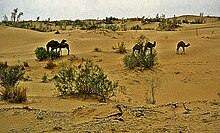Karakum

The Karakum (also Kara-Kum , Russian Каракумы ; Turkmen Garagum ; Uzbek Qoraqum ; literally "black sand") is a desert in Central Asia . Together with the neighboring deserts of Kyzylkum ("Red Sand") and Aralkum , it occupies most of the inner lowlands of Turan . It belongs to the rain shadow deserts.
The Karakum lies west of the Amu Darya River and belongs almost entirely to the territory of Turkmenistan , Uzbekistan only has a share in the northern peripheral areas . The desert is separated from the Caspian Sea in the west by the mountain ranges of the Great Balkans and the Kopet-Dag . The Karakum occupies about 90% of the area of Turkmenistan and has a size of over 400,000 km². The extremely arid region is crossed in the south by the approximately 1,445 km long Karakum Canal , perhaps the most complex irrigation project to date. Construction of the canal began in 1950.
history
The Karakum was once home to an early advanced civilization , which until now has been known as the Oxus culture or Oxus civilization, sometimes just as the " oasis culture ". This independent culture emerged at the same time as the well-known high cultures on the Nile , in Mesopotamia and in the Indus Valley , in the 4th millennium BC. Around 1700 BC. The culture disappeared in a hitherto unexplained way when a rural exodus towards Mesopotamia began.
Long after the oasis culture disappeared, the Silk Road ran through the Karakum. The oasis town of Merw was an important stopover on this trading route in antiquity and the Middle Ages .
In 2000, the Turkmen government began building a lake in the desert in the Karashor Valley near the city of Yaila. After the completion of the first construction phase on July 15, 2009, the first water flowed into the system, which was put into operation in the presence of Prime Minister Gurbanguly Berdimuhamedow . The inflow canals should reach a length of over 2500 kilometers, the lake should be 100 km long and 19 km wide. The area of 1900 square kilometers corresponds to almost three quarters of the Saarland . Every year 10 billion cubic meters of mineralized seepage water is to flow into the reservoir, which will have a total capacity of 132 billion cubic meters. The project should be completed in 2020.
physical geography
The lowlands of Turan stretches between the flat ridge of the Kazakh threshold with the Aral Sea in the north, the highly subdivided high mountains of Pamir and Hindu Kush in the east, the moderately high seismically active folds of the Kopet-Dag in the south and the Caspian Sea in the west.
Due to its continental location, the Karakum is extremely dry. Therefore, depending on the design of the subsoil, you can find hard clay desert, dry limestone slabs or isolated residual mountains surrounded by coarse rock debris. However, most of the area is covered by sandy desert , which is not black, even if the name "black sand" suggests this. It consists of the material that comes from the Amu Darya river valley and decaying sandstone. There are undulating sand covers instead of high dunes . Wind erosion usually prevails here .
climate
This region is characterized by the continental climate . In summer, the average temperature is between 27 ° C and 32 ° C. At high midday temperatures and a cloudless sky, the sand is heated up to 70 ° C. Storms are very common in the afternoon due to the heat . The winters are mostly cold (the January temperature is on average between −6 ° C and 5 ° C) and are determined by the duration of the frosts and the low snow cover, which usually only lasts a few weeks.
Most of the precipitation falls in spring and early summer, with the average annual precipitation between 100 mm and 150 mm.
fauna and Flora
For climatic reasons (high summer temperatures and cold winters), steppe vegetation with various types of grass and half-shrubs such as B. Artemisia kemrudica and A. badhysi, but also the Saxaul is at home here. The deserts are used as pastures for sheep and camels.
Here are caracal , sand cat , cobra , Four-toed tortoise , gecko and up to 1.5 m long Varanus home.
Natural resources
There are significant oil and gas deposits in the Karakum .
Web links
Individual evidence
- ↑ a b c Nazar Dovletli: Man-made lake in Karakum Desert Appears ( Memento of 13 December 2013, Internet Archive ) , CentralAsiaOnline.com, July 28th 2009, Access 4 February 2011
- ↑ ocamagazine.com: Project to go down in history in Turkmenistan , OCA, July 19, 2010, accessed February 4, 2011
- ↑ turkmenistan.ru: Water starts flowing into manmade Turkmen lake in Karakum desert , July 9, 2009, accessed February 4, 2011
- ↑ Igor G. Rustamov: vegetation of the deserts of Turkmenistan . In: V. Fet & KI Atamuradov (eds.): Biogeography and Ecology of Turkmenistan . Kluwer Adademic Publ., 1994, ISBN 0-7923-2738-1 , pp. 77-104 .
Coordinates: 39 ° 52 ′ 53.2 ″ N , 59 ° 18 ′ 55.2 ″ E


